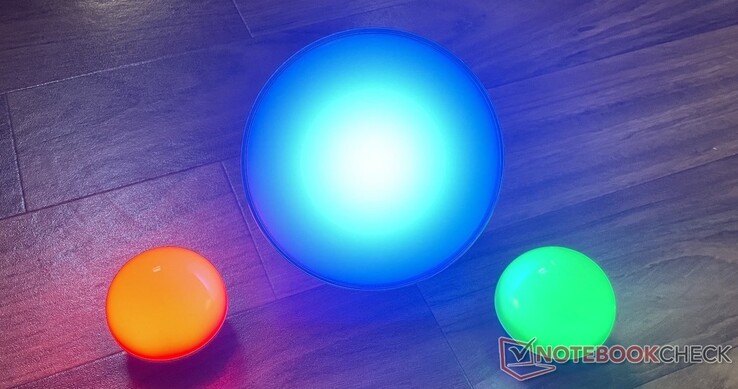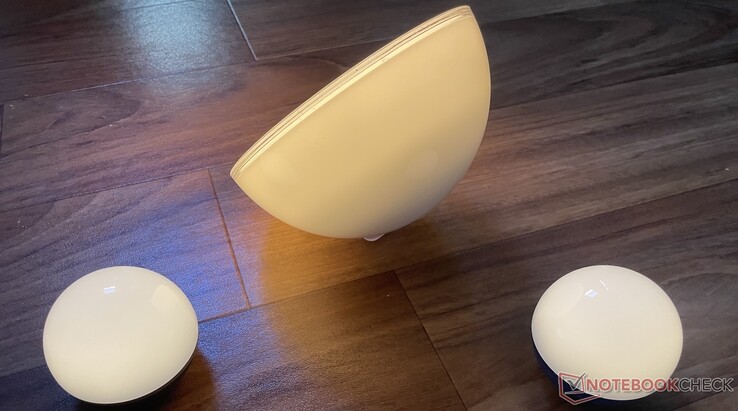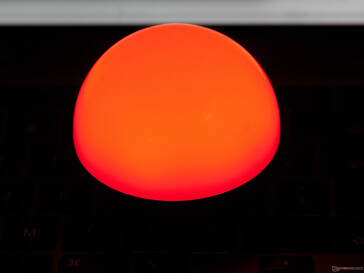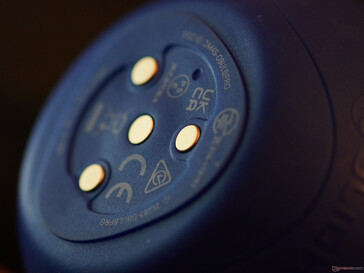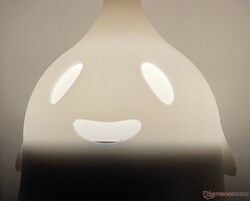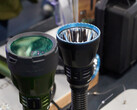Mobile LED lights in practical tests: Olight Obulb Pro is too expensive and Philips Hue Go does not last long
Battery-powered lights are something beautiful. Completely independent of the position, rooms can be illuminated with atmospheric light or in the evening the balcony or the barbecue can be decorated with beautiful light sources. The market is now large when it comes to battery-powered lights. In addition to the private sector, which is dominated by rather unknown manufacturers, there is also a professional market. Restaurants, for example, are important customers for battery-operated table lamps.
For this review, we chose a light system that could probably best pass for a lantern. The Olight Obulb Pro (58 mm high, 65 mm diameter, 105 grams/~2.3 x ~2.6 inches and ~3.7 oz) is therefore not a flashlight or classic table lamp. Rather, they can be set up flexibly and also hung up somewhere via magnet or accessories. They had to compete against a classic: Philips' old Hue Go lamp*.
In terms of price, both are at about the same level of 50 to 60 Euros (~$54-$65, street price). However, since we bought two of the Olight Obulb Pro for test reasons, the set is of course twice the price. The price is somewhat dependent on the distribution channel. Those who buy the Obulbs directly from Olight are offered many discounts. But the most important thing is that you can buy the lanterns without a charging cable. On Amazon, however, the offer of the Obulb Pro is greatly simplified*.
Notebookcheck bought the Obulbs directly from Olight. One was a Halloween set that included a "costume/cover" for it, but no charging cable. The other unit was purchased with a charging cable in the standard version.
Magnetic charging cable from Olight
Reducing unnecessary duplicate charging cables is extremely practical, but they are, unfortunately, proprietary. The lanterns are charged via a round magnetic connector, which has a USB-A plug on the other side. Those who have several products in the Olight universe will be familiar with this practical connection cable called MCC, which also makes it easier for the lights to achieve IPX7.
Big disadvantage of the connector: If you lose or misplace the cable, you can no longer charge the lights. And if the manufacturer goes out of business, you get a bigger problem.
Philips' battery powered Hue light doesn't have that problem. However, it still needs a barrel connector for charging. If in doubt, this can be found in the aftermarket, as long as the voltage and amperage are correct.
An entire room can be illuminated
When it comes to lighting, the Obulbs show their good side. In the default setting (without the app, more on that later), the lanterns cannot illuminate a room, but they serve as an excellent mood light, which also allows for some creative arrangements. Then, the orbs also last for several days. We tried this out with different light colors and even the alternating play. They usually last two complete days.
However, the alternating play, whether flowing color changes or strong steps, is unpleasantly hectic. The colors change too quickly, and unfortunately that cannot be adjusted.
At maximum brightness, the Obulbs approach the range of room lighting and should be positioned appropriately. One example is an emergency light at home, stuck to the refrigerator thanks to the integrated magnet. Ceiling lights with a lot of metal can also be used as a base. Both hanging and side-mounted, the magnets hold securely.
The Halloween kit is funny. It included a rubber cover, with which the light can then be hung up as a ghost - without any magnets at all.
Not the best color representation at Olight
The color representation of the spheres is not convincing. You can't see any individual LEDs, the diffuser above the sphere does a decent job, but some shading can be seen inside the sphere. In addition, the colors such as red or green appear unclean. This is no comparison to the very small Fenix CL09, for example, which delivers very clean-looking colors. Unfortunately, this cannot be captured with the camera. Smartphone cameras in particular fail and sometimes show completely wrong colors. This is only marginally better with a Nikon Z50. Sample photos of the CL09 can be found in our Hotel test of the Apple TV and Homepod Mini.
The Obulbs, on the other hand, look very good in the smartphone cameras, but also with the Nikon Z50. By the way, this is an effect that is also known from TVs. Representing red brake lights of cars well is still a challenge today in terms of correct display. That hasn't changed even with HDR.
Philips Hue Go consistently delivers better results here, but with a different approach. The color selection is definitely limited. The Hue Go does not produce a clear yellow, for example. Blue also looks somehow weak. It is also annoying that the LEDs on the side shine through. The highlight of the Hue Go is of course the Cozy Candle mode. This simulates the flickering of a candlelight, which is perceived rather unconsciously. In addition, the light can be integrated into the Zigbee system at home. That's not possible at all with Olight's Obulb Pro. The powerful Hue app is well known, so we won't go into it here.
App control with quirks and interesting functions
With the Obulb, on the other hand, this is a special feature. These self-sufficient small lights rarely have app control. However, the app has numerous quirks. While pairing is very easy, further operation is sometimes fraught with annoyances.
Speaking of special, the pairing can be transferred to another smartphone via QR code. We successfully transferred the control from an iPhone 12 to an iPhone SE without a new pairing. After that, both smartphones worked as controls via Bluetooth - in fact, remote control is not possible at all.
Once the lanterns are paired, the brightness and light color can be adjusted via the app. In addition, the lanterns can even be switched on and off in groups. However, the light color and brightness cannot be set for all lights in the app. Rather, activating a group loads the last state of each individual light.
Unfortunately, the desired light concert cannot be saved. The group function does not seem well thought out. In addition, the app sometimes cannot connect to the lights. Then the lanterns have to be activated manually first. We suspect that the Bluetooth function goes dormant after a while.
Annoying during transport
Olight has given little thought to the transport scenarios. The most annoying point is certainly the switching mechanism. The lantern is activated by pressing on a rather large surface. The problem: This happens accidentally in a bag/backpack rather easily. Even a small bump is enough for this. The lanterns do feature a lockdown mode (press and hold the button) but that doesn't rule out that the lights will leave the lock mode by accident in your backpack. What the lanterns lack is a slide switch that fixes the on/off modes. Unfortunately, there is also no transport bag, which one might expect considering the price. In addition, a transport bag would protect the easily scratched sphere surface.
Philips at least does the switch better, namely it is recessed. This does not rule out accidental activation in a backpack, but it makes it less likely. However, Philips Hue Go is only suitable for transport to a limited extent because it is simply too big.
Good battery runtimes, high self-discharge
The runtimes of the small Olight lanterns are consistently good. Several days on the lowest setting are no problem. Olight speaks of a maximum of 85 hours. We were able to confirm at least two full days several times. Increasing the brightness for a short time does not have a big impact either. The app displays an estimate of the runtime, which is quite reliable. However, only two hours are feasible at maximum brightness. The light is dazzling then, so it is better to attach it somewhere else instead of having it on the table.
The high self-discharge is problematic. During the test, it happened to us several times that the lanterns were suddenly empty or almost empty after about a week. Too bad.
With Philips, the runtimes are considerably lower despite the size. With the Hue Go, it's over after one evening in any case. Thus, the Hue Go cannot be used for several days. According to the manufacturer, the maximum runtime is 18.5 hours, or a whole evening in practice. However, this is only possible in Cozy Candle mode or at low brightness. In all other light scenarios, Philips advertises 2.5 hours. In practice, it is definitely more when you do not use the full power. We also noticed a self-discharge in the Hue Go. However, since it is less suitable for mobile use, we did not consider it further. In a realistic scenario, the Hue Go is very often connected to the power cord anyway, since it simply has to be recharged every day to remain usable. Anything else makes little sense.
Conclusion
Considering a budget of around 50 Euros (~$54), the decision between one or the other solution is difficult. The Philips Hue Go is the best value for mood lighting as the volume of light is spread over a bigger surface. It is impressive what the light can do. In addition, there is the subtle flickering, which Philips has implemented excellently. As a permanent light at home that is only rarely used on the road, the money is better invested in the Hue Go.
If, on the other hand, you need to plan emergency lighting situations or travel, the Obulb Pro from Olight is the better choice. However, you should get a transport case so that the light does not turn on when on the go. With a current price from 40 to 50 Euros (~$43 to $54), the tiny, albeit powerful light is quite expensive, though. We find the recommended retail price of 60 Euros (~$65) far too expensive for what it offers, especially in comparison with the more powerful Philips Hue Go.
In return, you can take many of them with you - just having two is already fun. You can illuminate your hotel room nicely with them. During the test, we also felt the need to throw a good dozen globes into a swimming pool. In the absence of a Notebookcheck test swimming pool, we fortunately did not succumb to this temptation, which can quickly drive you to ruin.
The manufacturer's advertising is also cunning in this regard. Ads don't miss the opportunity to use dozens of lanterns and show how much fun it is, especially for children. If you have children, you'd better not show them what the manufacturer has to offer. It could cause quarrels and disappointment due to the weaknesses of the app's group function. If you really want to buy more lanterns, you should first try out with two to see if it is worth the fiddling.
Overall, the problems with the app are negligible, at least when used individually. However, you should be aware that many functions cannot be used without the app and the app quickly gets annoying with multiple lanterns due to reliability issues. The Obulb is only suitable as an emergency light to a limited extent due to the high self-discharge. Simply leaving it lying around is not an option.
Disclosure: The Olight Obulbs tested here were purchased by the author at his own expense. The Philips Hue Go was lent by Signify for testing purposes.




